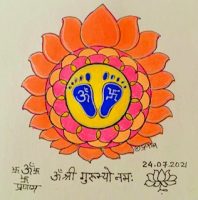Before proceeding with penning down my musings on “Svadhyay” I find here an opportunity to profusely thank Venerable Meena Om ji, the originator and the exalted driving force behind this innovative platform of pranam.org, to have encouraged me to lay bare my personal experiences, which I think, are never ending to uphold the infinite concept of swadhyay. It would be pertinent to refer to what Swami Vivekanand once told a seeker when asked how many persons have been influenced by his sayings. He said that even if he can change only one person in his life time, it will make his life well lived for. As truth is eternal and multi faceted, therefore, Swami Vivekanand succinctly opined that “Truth can be stated in a thousand different ways, yet each one can be true.” Through these musings what I am conveying about my personal experiences with “svadhyay” is true as well.
All the seekers participating in this spiritual exercise are blessed to have taken birth or having their roots in this Dev Bhumi called Bharat and following the Sanatan Values of Life. Though ostensibly, it may seem superfluous, yet it is reiterated for highlighting that Hinduism, popularly called a religion for identification, is in fact, a philosophy of life, a culture to inculcate or simply put, is a way of life. It’s an enigma, that has defied a strait jacket explanation over the aeons. As per Encyclopaedia Britannica, as many as 61 ancient civilizations, including the Indus Valley Civilization, came into being at different times and regions in history, flourished and declined, into oblivion except for one, that is, the Sanatan Hindu Dharma. Like every faith, Hinduism has at its core, a fascinating nucleus of beliefs conducive to the spiritual well-being of its followers and these values have not only sustained it, but have made it immortal.
Sanatan Hindu approach to existence has been to focus more on the esoteric aspects of their beliefs as a pre-condition for peace in the world. The mundane questions of social justice and peace based on exoteric aspects of human existence has been at core of religious faiths, namely, Judaism, Christianity, and Islam, professed in the western world. Without being too complex, the difference between esoteric and exoteric aspects of any faith or religion can be explained by two types of forces, as known to any student of science. The centrifugal force, which acts inside out while the centripetal force acts outside in. Interestingly, all the systems bestowed by the Mother Nature, in any living body, which includes human body, act on the principle of centrifugal force. Once you have understood this natural phenomenon on the physical plane, it will be easy to comprehend the crucial difference in the line of treatment as per Allopathic, Homeopathic and Ayurvedic systems of medicine. Homeopathic and Ayurvedic Systems harness centrifugal force to restore a sick body to a state of health, while the Allopathic System revels in using the centripetal force to treat a patient and in this unnatural attempt, the allopaths wreak havoc to the human machine.
On the spiritual plane also the same
hallowed principle of centrifugal force is to be harnessed, so opined the Great
Rishis of yore. Echoing that eternal truth, Swami Vivekanand said, “You have to
grow from the inside out. None can teach you, none can make you spiritual.
There is no other teacher but your own soul.
Take up one idea. Make that one idea your life;
dream of it; think of it; live on that idea. Let the brain, the body, muscles,
nerves, every part of your body be full of that idea, and just leave every
other idea alone. This is the way to success, and this is the way great
spiritual giants are produced.” Please
remember I chose to make Greed as the vice I should always shun for my
spiritual progress. So far this has been the sheet anchor of my life. Needless
to say that If one focuses only on outer peace
and creating social justice in the world, as the Western Religions emphasize to
do, but not on inner peace, then people’s unresolved inner conflicts can be
projected out onto the world, creating scapegoats, prejudices, and conflicts,
therefore making it difficult to create social justice and peace in the world
(the ostensible goal). Hence a history of continual inter se strifes, violence,
unrest and negative destructive vibrations all around.
On the other hand, if one focuses only on inner peace, self enlightenment, etc. as lies at the core of Sanatan beliefs, then social injustices and structural violence in the world created by outside negative forces, which are not addressed by society and people, will tend to make it difficult for those people, who are engaged in peaceful efforts to enlighten their inner selves, to transcend their outer conditions of life, thus making it difficult for them to attain inner peace (the ostensible goal). Faced with such a practical paradoxical situation, the eternal teachings of our ancient Rishis and cap it all by Yogeshwar Lord Krishna, clearly delineate a royal path leading to a dynamic and synergistic relationship between inner and outer peace: by focusing on both aspects of peace, each aspect of peace–i.e., inner or outer–increases the probability that more people will also be able to attain the other aspect of peace. During last few weeks, the expounding of such practical situations by venerable Meena Om ji has been a boon to all seekers. My musings on other aspects of “Svadhyay” to continue.





Gratitude for sharing Gyan …..Pranam OM OM OM ..